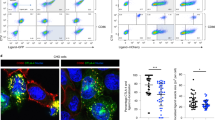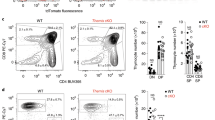Abstract
T-CELL accessory molecules, particularly CD4 and CD8, seem to be involved in the control of T-cell activation by antigen. Precisely how such molecules operate is not fully understood, but evidence to date suggests a dual role, as receptors binding ligands on stimulator cells1,2 and by direct or indirect involvement in intracellular signalling events3–5. In mouse, truncated 'tailless' CD8 molecules occur naturally (CD8α′ polypeptides) and although they are expressed on the surface of thymocytes, they are not expressed on the surface of mature T cells6. In this study, we show that truncated CD8 molecules are impaired in their ability to interact with the protein tyrosine kinase, p56lck, and have decreased ability to restore immune responsiveness in vitro. Our data support a dual function for CD8 molecules correlated with expression of external domains and cytoplasmic domains, respectively. Both functions appear to be critical for a competent immune system in vivo.
This is a preview of subscription content, access via your institution
Access options
Subscribe to this journal
Receive 51 print issues and online access
$199.00 per year
only $3.90 per issue
Buy this article
- Purchase on Springer Link
- Instant access to full article PDF
Prices may be subject to local taxes which are calculated during checkout
Similar content being viewed by others
References
Doyle C. & Strominger, J. L. Nature 330, 256 (1987).
Norment, A. M., Salter, R. D., Parham, P., Engelhard, V. H. & Littman, D. R. Nature 336, 79–81 (1988).
Emmrich, F., Strittmatter, U. & Eichmann, K. Proc natn. Acad. Sci. U.S.A. 84, 8298–8302 (1986).
Ledbetter, J. A. et al. Eur J. Immun. 18, 525–532 (1988).
Jönsson, J-l., Boyce, N. W. & Eichmann K. Eur. J. Immun. 19, 253–260 (1989).
Walker, I. D. et al. Immunol. Rev. 82, 47–77, (1984).
Zamoyska, R. & Parnes, J. R. EMBO J. 7, 2359–2367 (1988).
Gabert, J. et al. Cell 50, 545–554 (1987).
Rosenstein, Y., Ratnofsky, S., Burakoff, S. J. & Herrmann, S. J. J. exp. Med. 169, 149–160 (1989).
Rudd, C. E., Trevellyan, J. M., Dasgupta, J. D., Wong, L. L. & Schlossman, S. F. Proc. natn. Acad. Sci. U.S.A. 85, 5190–5196 (1988).
Veillette, A., Bookman, M. A., Horak, E. & Bolan, J. B. Cell 55, 301–308 (1988).
Veillette, A., Bookman, M. A., Horak, E., Samelson, L. E. & Bolan, J. B. Nature 338, 257–259 (1989).
Goodman, T. & LeFrancois, L. Nature 33, 855–858 (1988).
Parrott, D. M. V. et al. Ann. N. Y. Acad. Sci. 409, 307–320 (1983).
Swain, S. L. Immunol. Rev. 74, 129–142 (1983).
Kisielow, P., Teh, H. S., Blüthmann, H. & von Boehmer, H. Nature 335, 730–733 (1988).
Sha, W. C. et al. Nature 336, 73–76 (1988).
Gay, D. et al. Nature 328, 626–629 (1987).
Hua, C., Boyer, C., Guimenzanes, A., Alpert, F. & Schmitt-Verhulst, A. M. J. Immun. 136, 1927–1936 (1986).
Oi, V. T., Morrison, S. L., Herzenberg, L. A. & Berg, P. Proc. natn. Acad. U.S.A. 80, 825–829 (1983).
Gunning, P., Leavitt, J., Muscat, G., Ng, S-Y & Kedes, L. Proc. natn. Acad. Sci. U.S.A. 84, 4831–4835 (1987).
Zamoyska, R., Vollmer, A. C., Sizer, K. C., Liaw, C. W. and Parnes, J. R. P. Cell 43, 153–163 (1985).
Ledbetter, J. A. & Herzenberg, L. A. Immunol. Rev. 47, 63–90 (1979).
Author information
Authors and Affiliations
Rights and permissions
About this article
Cite this article
Zamoyska, R., Derham, P., Gorman, S. et al. Inability of CD8α′polypeptides to associate with p56lck correlates with impaired function in vitro and lack of expression in vivo. Nature 342, 278–281 (1989). https://doi.org/10.1038/342278a0
Received:
Accepted:
Issue Date:
DOI: https://doi.org/10.1038/342278a0
This article is cited by
-
PD-1 suppresses TCR-CD8 cooperativity during T-cell antigen recognition
Nature Communications (2021)
-
Targeted suppression of autoreactive CD8+ T-cell activation using blocking anti-CD8 antibodies
Scientific Reports (2016)
-
Ligand-engaged TCR is triggered by Lck not associated with CD8 coreceptor
Nature Communications (2014)
-
TCR-MHC docking orientation: natural selection, or thymic selection?
Immunologic Research (2008)
-
CD8α is expressed by human monocytes and enhances FcγR-dependent responses
BMC Immunology (2007)
Comments
By submitting a comment you agree to abide by our Terms and Community Guidelines. If you find something abusive or that does not comply with our terms or guidelines please flag it as inappropriate.



